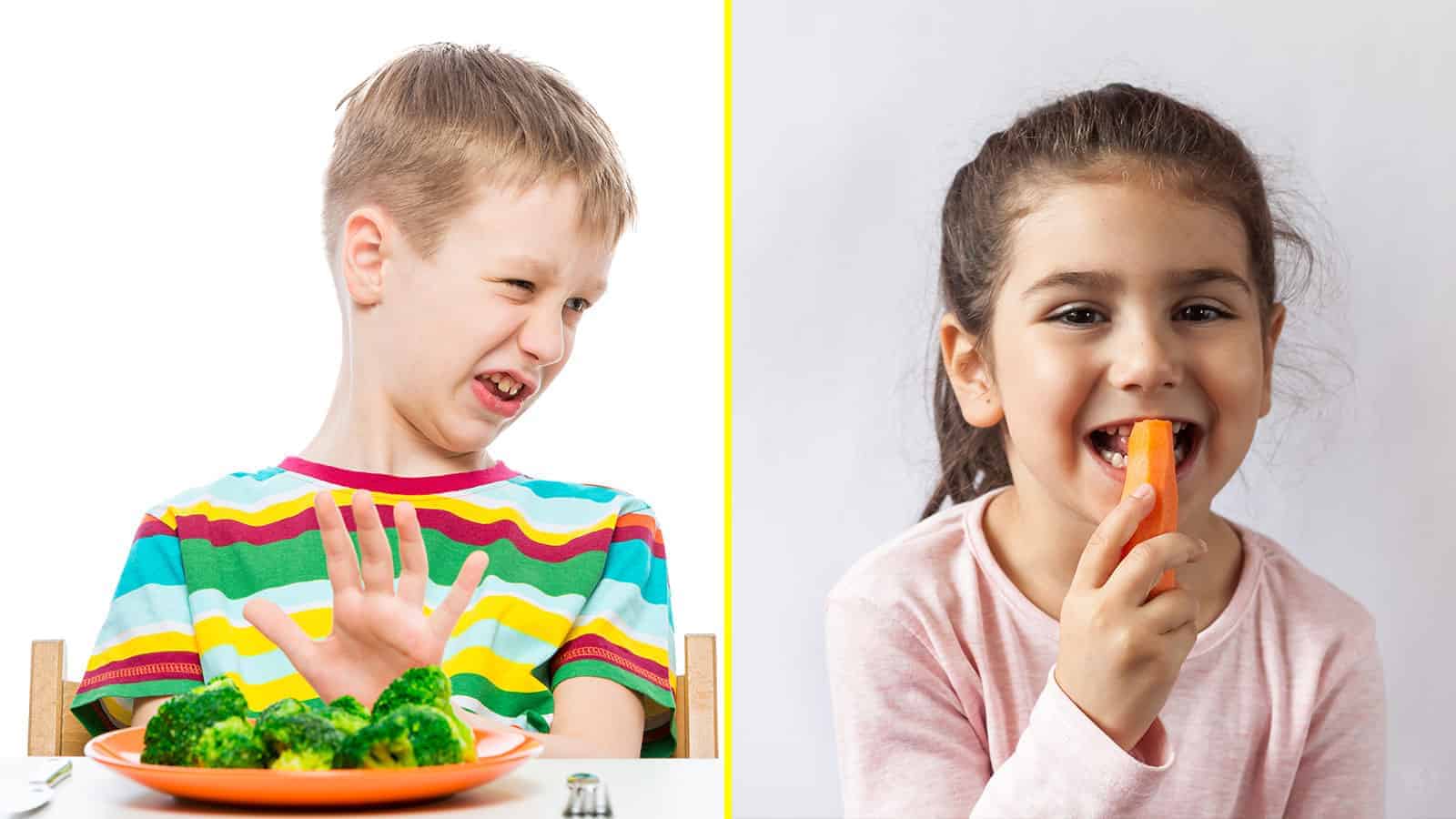When it comes to feeding our children, we all want the best in nutrition (first of all) and flavor for them. It gives our hearts great joy when we see them chow down on their mash potatoes, chicken, and more, knowing their tiny tummies are full, and they are getting all the nutrients that they need.
However, there are times when they won’t eat a particular vegetable or drink their milk, for instance. We may even bribe them with money, candy, or a sticker to eat those funny-looking, green vegetables that look like little trees (i.e., broccoli). However, many dieticians and pediatricians agree that using these tactics are not the best way to ensure they are getting enough nutrients.
Another thing to note is that even though a child may not try a particular food, the first few times doesn’t mean he/she won’t like it eventually. The children may not taste the new offering until you expose it to them around 15 times.
So, if your child is a picky eater, which many are, it’s good to expose them to alternate foods as much as possible, especially while they are very young, like toddlers. For example, if he/she loves sandwiches, you should rotate the bread by replacing it with whole wheat pita, whole wheat bread, whole-grain English muffins, and whole wheat wraps. For spreads, for instance, you should try seed or nut butter, cream cheese, hummus, and avocado.
FOODS CHILDREN LOVE, ACCORDING TO PEDIATRICIANS
• Small pieces of various healthy food choices:
When serving your child different healthy food choices, keep in mind that they must have small pieces to keep from encountering a choking hazard. American Academy of Pediatrics (AAP) recommends that parents should avoid popcorn and even hot dogs unless you cut up the hot dogs into small pieces.
The following includes tasty food choices that are best when served in small pieces:
1. Marshmallows (in small amounts, to add a hint of sweetness)
2. Raw baby carrots
3. Seeds
4. Beans-the most significant sources of fiber and a great source of protein, particularly for children that are prone to constipation. However, they are easy to chew and are tasty, especially with great seasonings.
• Small, round, and triangular-shaped, healthy food choices:
5. Cherry tomatoes
6. Whole grapes
7. Chicken nuggets
8. Quesadilla- Fill a quesadilla wrap with various vitamins and minerals. Get creative here! Choose a vegetarian offering filled with beans and cheese or one with, or with meat, such as with grilled chicken or ground beef.
9. Sandwiches
Whether it is peanut butter with honey or sliced banana circles or deli meat with cheese, cutting the sandwiches in triangular shapes is vital for easy eating. Also, children will be overjoyed eating sandwiches with a unique shape.
Another excellent example of triangular sandwiches for easier eating is taking a whole wheat tortilla and put in sauteed black beans and spinach. Then, sprinkle cheese on top of the tortilla and cut it into little triangle sandwiches.
• Other healthy foods that you should cut into bite-sized pieces:
10. Raw fruit
11. Fresh celery sticks
12. Different raw vegetables, such as cauliflower, and cucumbers
Potatoes, raw vegetables, or raw fruits should always be cut into small, bite-sized pieces that are no bigger than a one-half inch size. Other good choices of vegetables include canned, fresh veggies, such as peeled cucumber, zucchini slices, or quartered cherry tomatoes. Many of these fruit and veggies are spectacular for vitamin C, in which many people, adults, and kids are not getting enough of.
• Complimentary food items to combine with other food
13. Peanut butter
14. Yogurt
15. Cottage cheese
16. Applesauce
17. Sliced avocado
18. Crackers
These choices and more are complimentary to many other flavors for children’s lunch boxes. The following includes various ways to use these complimentary food items to create very tasteful and nutritional treats:
- Mashed avocado and black bean roll-ups with banana nut butter, ranch dressing, celery, and 1/4 cup pretzels
- Pita pizzas with five slices of cucumber, zucchini, 1/4 cup trail mix, and five strawberries cut into quarters
- Avocado sandwich, six small pieces of your choice of cheese, six crackers, and eight halved grapes
- 1/4 cup of chopped pear, 1/4 cup of turkey meatballs chopped in pieces, 1/4 cup of cereal O’s, and 1/4 cup of well-cooked of green beans
- 1/4 cup of chopped canned apricots, five animal crackers, 1/4 cup of cooked asparagus tips, 1/4 cup of brown rice, and 1/4 cup of shredded chicken
- One small, homemade, whole-grain muffin torn in pieces, 1/4 cup of strawberry halves, 1/2 cup of Greek whole milk yogurt, and 1/4 cup of canned carrot circles
- 1/2 banana, 1/2 sunflower seed butter sandwich, and 1/2h cup of Greek whole milk
- Nut butter on a sheet of Graham crackers, 1/2 cup of cottage cheese, and 1/4 cup of canned pineapples
- Whole wheat mini-bagel with carrot chips and a string cheese
- Olive oil on whole wheat pasta with a veggie-based and fruit-based smoothie
- Yogurt with whole wheat crackers and fruit
- Tuna fish with guacamole, mayo, and pretzels for dipping
- Brown rice cakes with shredded mozzarella cheese, guacamole spread, and diced tomatoes sprinkled on top
A note on avocados
Avocados are amazing- they are one of the fruit in the world that has the most nutrients. It has vitamins, such as vitamin C, E, K, and B6. It also has riboflavin, niacin, folate, magnesium, potassium, pantothenic acid, beta-carotene, omega-3 fatty acids, and lutein. Avocados have some fat content, as well. However, healthy fat is beneficial in boosting skin health, and these fats enhance the absorption of certain minerals, nutrients, and minerals.
Kids should have a healthy diet rich in vegetables, fruits, fat-free dairy products, low-fat dairy products, and whole grains. The foods could be either organic or conventional.
Cube-sized shredded or soft meat is a great iron source. You can roast or stew pork loin, tender roast beef, or chicken with a lot of liquid, for instance. Two one-inch cuts of this meat are over half of what a toddler needs in protein for the day.
Also, it’s good to regularly include healthy fats, such as omega-3s in cod and salmon, in young children’s diets while they are young instead of risking them to be aversive while trying them when they are older. Furthermore, many of these foods have vitamin D, which is vital because having low vitamin D can lead to various serious diseases.
OTHER IMPORTANT FACTS ABOUT NUTRITION AND YOUNG CHILDREN
Another thing to consider when it comes to young children is their portion sizes. A dietician from the Academy of Nutrition and Dietetics stated that toddlers only need about 25-50% of an adult portion. So, while a banana gives up to four fruit servings, a toddler will be full of it and won’t be interested in eating other foods. With that in mind, it is vital to make the serving sizes of various healthy food choices that will amount to no more than 25 to 50% of what you would eat.
The dietician also stated that babies are born with the inherent knowledge of when they are hungry and whey they are not. We, as parents, sometimes override that natural talent of theirs.
Also, the elementary school environment can assist in teaching kids about eating behaviors and dietary patterns. Approximately 50% of U.S. schoolchildren participate in the National School Lunch Program (NSLP). The requirements of these meals are consistently served with the Dietary Guidelines for Americans and adhere to the recommended dietary allowance for vitamin C, vitamin A, calcium, iron, and calories. Also, schools offer access to other food sources, such as vending machines, which may contribute to low diet quality depending on the foods’ nature.
There are specific food allergens to beware of in some high-quality foods. The eight most common food allergens include wheat, dairy, eggs, shellfish, fish, peanuts, soy, and tree nuts. (Whole peanuts shouldn’t be served to young children anyway, seeing that this is a choking hazard.)
So, it’s imperative to check with the manager at your child’s daycare to see whether your child reacted to any foods that are prone to food allergens. Even if the child had a slight reaction, it’s still imperative to find out and not take it lightly.
 FINAL THOUGHTS ON FEEDING THE PICKIEST CHILDREN
FINAL THOUGHTS ON FEEDING THE PICKIEST CHILDREN
We all, as parents, want what is best for our youngsters. This sentiment is even true when it comes to them getting adequate nutrition.
So, if your children are picky eaters, which many are, exposing them to other foods as much as possible will go a long way. So, even though a child may not try a particular food the first few times, it doesn’t mean he/she won’t like it eventually. And eating the 18 foods mentioned above are food choices that even the pickiest of kids will eat.

















